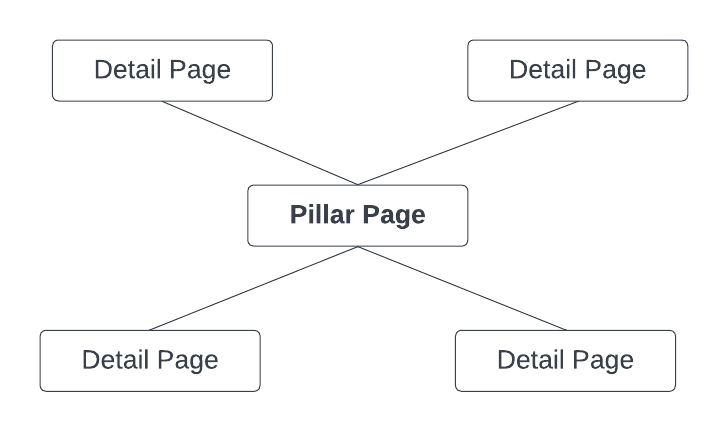
It takes a lot of content about a topic to increase search traffic results. Google takes several factors into account when deciding how high to rank your website for a particular search, including:
- Overall website quality
- The amount of content related to the topic
- The organization of the content on your website
For most content, it takes many relevant pages for Google to consider your website an authority on the topic.
Pillar Content Model
The Pillar Content Model consists of a Pillar Page supported by multiple detailed pages on the topic.

The pillar page is a comprehensive page that may have 3,000 or more words on the subject matter. The detail pages are typically shorter pages that cover a specific detail. Seven hundred words is a good target length for the detail pages, but they can be effective with fewer words, but longer can be beneficial.
If the subject matter is complex, organize it into a few sub-topics and numerous detail pages. A good target length for the sub-pillar pages is 1,200 words, and the detail pages can be 500-700 words.

The Pillar Content Model is often called the Cornerstone Content Model or the Hub and Spoke Content Model. The hub and spoke model is illustrated like this:

Defining Content
Keyword research determines the topics to write about and how to organize them.
You can start with a shoer descriptive content terms. Examples of topics that a commercial printer might use as pillar topics include:
- Direct mail
- Retail graphics
- Digital printing
Keyword research helps determine the topics for each page. These detailed topics can be implemented as website pages or blog posts. Sub-pillar pages (or blog posts) organize complex issues that require numerous pages to cover all the material.
There are many ways to find the topics to write about. SEO tools such as Semrush or Ahrefs can find and analyze keywords. These tools find longtail keyword phrases that can form topic ideas for the detail pages.
Google search can also find detailed topics. Search on the top-level topic, and the search engine results page will Google will provide topic ideas in the People also ask and Related searches sections on the page.
Prioritize and Implement
Define the pages your want to create using the relevant keyword phrases you’ve selected.
The first step is to write the pillar page. The pillar page should be a comprehensive page that briefly covers all the topics on the detail pages. How quickly you create the detailed pages depends on your resources, budget, and business needs.
Using a pillar content strategy can yield many benefits. Your website will be an authoritative resource on the topic, which:
- Increases your chances of appearing on search page one on a topic
- Reduces the time to rank
- Makes website visitors consider you an expert on the topic
- Gives your sales team content to use during the sales process
##
Read last month’s post from Todd: https://printmediacentr.com/improve-public-relations-with-these-6-social-media-steps
See all of Tod’s posts here

Tod Cordill has worked in a variety of industries including software, manufacturing, printing, and eCommerce. He currently helps B2B companies integrate digital marketing channels into existing sales and marketing efforts by combining his P&L perspective with an engineering problem-solving structure. Get in touch and learn how Moderno Strategies can help you efficiently drive business growth. Connect with Tod: @todcordill on Twitter and on LinkedIn












